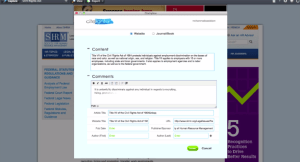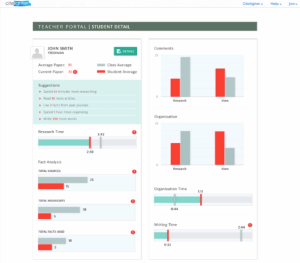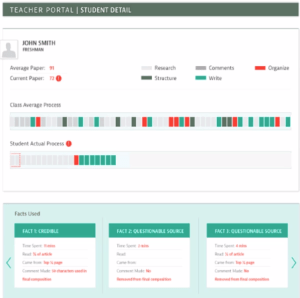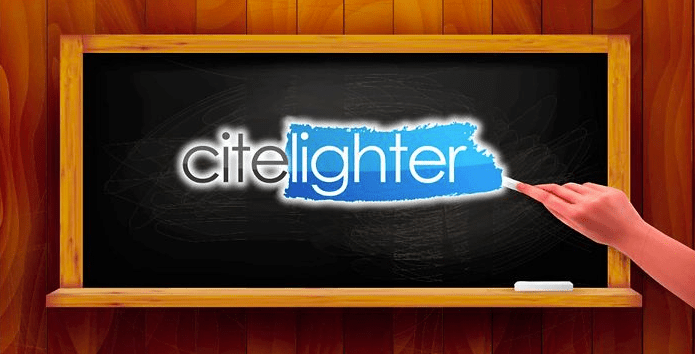When Citelighter first emerged in the fall of 2011, the education startup was on an ambitious mission to help students take the pain out of online research. With the enormous amount of content on the Web, students struggle to keep track of and manage bibliographical data and relevant links that are so critical to completing research papers and homework assignments.
Building out a giant learning database and browser extension, Citelighter worked to create an academic research platform that would make it easy for students to manage resources, cite online and offline content and quickly create an accurate bibliography. By searching its database of knowledge cards, students could use Citelighter to quickly find relevant materials, while teachers could encourage their classes to use its bibliography tools to prevent against plagiarism.
Today, however, with $1.5 million from a laundry list of venture firms and angel investors, Cightlighter is fueling up for a change course — a move which will take down a road that has potentially even more interesting (and ambitious) implications. Having gathered a sizable and unique data set on the habits, preferences and behaviors of students as they navigate the academic research and writing process, Cightlighter is looking to leverage this information (and build on it) with the goal of giving teachers greater insight into the work habits and cognitive footprints of their students.
While that may sound a little opaque or dubious, simply put, Citelighter wants to tackle the problem of writing proficiency in the U.S. educational system and, by giving teachers tools to help them better understand how students write, help improve writing proficiency across the board. The size and extent of the problem, say co-founders Saad Alam and Lee Jokl, can be found in the most recent National Assessment of Educational Progress’ survey of writing skills.
The study found that only 24 percent of high schools seniors in the U.S. can write at a proficient level and only 3 percent at an advanced level. This means that 73 percent of graduating seniors across the U.S. educational system enter the work force without the requisite skills or the ability to write proficiently.
To address this problem, Citelighter is attempting to map out the exact steps that each individual student takes throughout the writing process, using its platform to capture and visualize that data in an effort to help teachers and students learn more efficiently. The co-founders say that, while they were originally focused on a simple Web highlighting tool, after a year of watching teachers use their platform in the classroom for everything from poetry and advanced research to ESL education, they noticed a pattern.
 That is, students who used a “scaffolded” approach to writing in combination with Citelighter’s tools were found more likely to develop a deeper understanding of the concepts they learned, and were able to more effectively communicate those concepts. So, over the last year, the startup quietly began building a broader tool to accommodate its most prevalent (and interesting) use case.
That is, students who used a “scaffolded” approach to writing in combination with Citelighter’s tools were found more likely to develop a deeper understanding of the concepts they learned, and were able to more effectively communicate those concepts. So, over the last year, the startup quietly began building a broader tool to accommodate its most prevalent (and interesting) use case.
While the startup is keeping a lid on the full feature list and what the platform will ultimately look like, the founders did tell us that the goal is to turn Citelighter into an “all-purpose writing platform.” The new Citelighter, which will inevitably see the startup re-brand and totally re-focus around this new platform (and direction), aims to provide an organizational framework through which teachers can help improve their students’ critical thinking abilities and writing proficiency. Furthermore, according to the founders, multiple “PhDs in writing and education technology” as well as advocacy organizations like the National Writing Project, have begun to pilot the new platform.
Furthermore, the new platform will continue developing the idea which led to its “Cognitive Prints” — a data visualization platform and tools it initially announced in September. Broadly, the platform starts with a basic workflow and collaboration layer, which allows students to automatically cite content found online and collaborate with one another as they complete research and writing assignments.
Using a framework that is integrated with both Google Docs and Microsoft Word, Citelighter tracks each student’s behavior, capturing key information on the student’s approach to writing and their process — in other words, how they work, how long it takes them to complete assignments and how they approach citations, bibliographies and incorporate source material. Teachers can then use the platform’s tools, like its visual log of events, to get deeper visibility into students’ research, organization and writing.
Referred to as “Cognitive Prints,” these tools give each student a personalized fingerprint, which the founders want to stand as a visual representation of their “cognitive processes.” These Prints allow teachers to view a realtime, color-coded map of the student’s work habits, with sequential task analysis that takes them back through each step the student went through to complete the assignment.
 Citelighter then gives teachers access to a view of their entire classroom’s “Cognitive Prints” set, enabling them to see how each of their students are performing or getting on at any particular time. In addition, teachers can view each student’s individual projects, like what content they’re using, and how they think about and organize that content, for example. in a dashboard to see how all students are performing at any one time. Finally, educators can then share assignments, tips, worksheets and the like via Citelighter’s Google Docs integration.
Citelighter then gives teachers access to a view of their entire classroom’s “Cognitive Prints” set, enabling them to see how each of their students are performing or getting on at any particular time. In addition, teachers can view each student’s individual projects, like what content they’re using, and how they think about and organize that content, for example. in a dashboard to see how all students are performing at any one time. Finally, educators can then share assignments, tips, worksheets and the like via Citelighter’s Google Docs integration.
While the description may not set your heart a-thumpin’, the deeper and more robust the data becomes that goes into Cognitive Prints, and the more interactive and three-dimensional the visualizations become, the more interesting the implications become. The co-founders tell us, for example, that the ultimate goal for these visualization tools (and the platform itself) is to give students the ability to not only better understand and dive into how they think, but potentially benchmark their own work habits or “Cognitive Prints” against other students.
For example, a student struggling with mastering organizational skills in their writing development could compare their “Cognitive Print” to that of the student in the class who excels at organization. They could peruse through that student’s thought process, following along step by step, sequentially, as he or she completed a research or writing assignment.
 With personalization becoming a mandate (and buzzword) within education, one could see this kind of tool going a long way towards increasing the personalized nature of writing education. Those struggling could benchmark or compare with more advanced students in the class, and more advanced students could use those from students in the next grade, or their teachers, or, should Citelighter ever reach critical mass, maybe even a professional writer.
With personalization becoming a mandate (and buzzword) within education, one could see this kind of tool going a long way towards increasing the personalized nature of writing education. Those struggling could benchmark or compare with more advanced students in the class, and more advanced students could use those from students in the next grade, or their teachers, or, should Citelighter ever reach critical mass, maybe even a professional writer.
Today, there’s a lot left to be done before the startup can realize any of these lofty goals, but considering where it started, it seems as if Citelighter is headed in a much more interesting direction, and one that could potentially have a much bigger impact.
The investors contributing to Citelighter’s latest funding round today include New York Angels, Blu Venture Investors, the EdTechFund, Baltimore Angels, as well as individual investors like NEA co-founder Frank Bonsal, Jr., Diker Management’s Ed Hajim and Camden Partners’ David Warnocke. And, as a result of the round, Alessandro Piol of Vedanta Capital and AlphaPrime Ventures and Canal Group and Blu Venture Investors’ Kevin Hollins will be joining the startup’s board of directors, with Sacha Levy of New York Angels and Stephen Dukker joining as observers.
